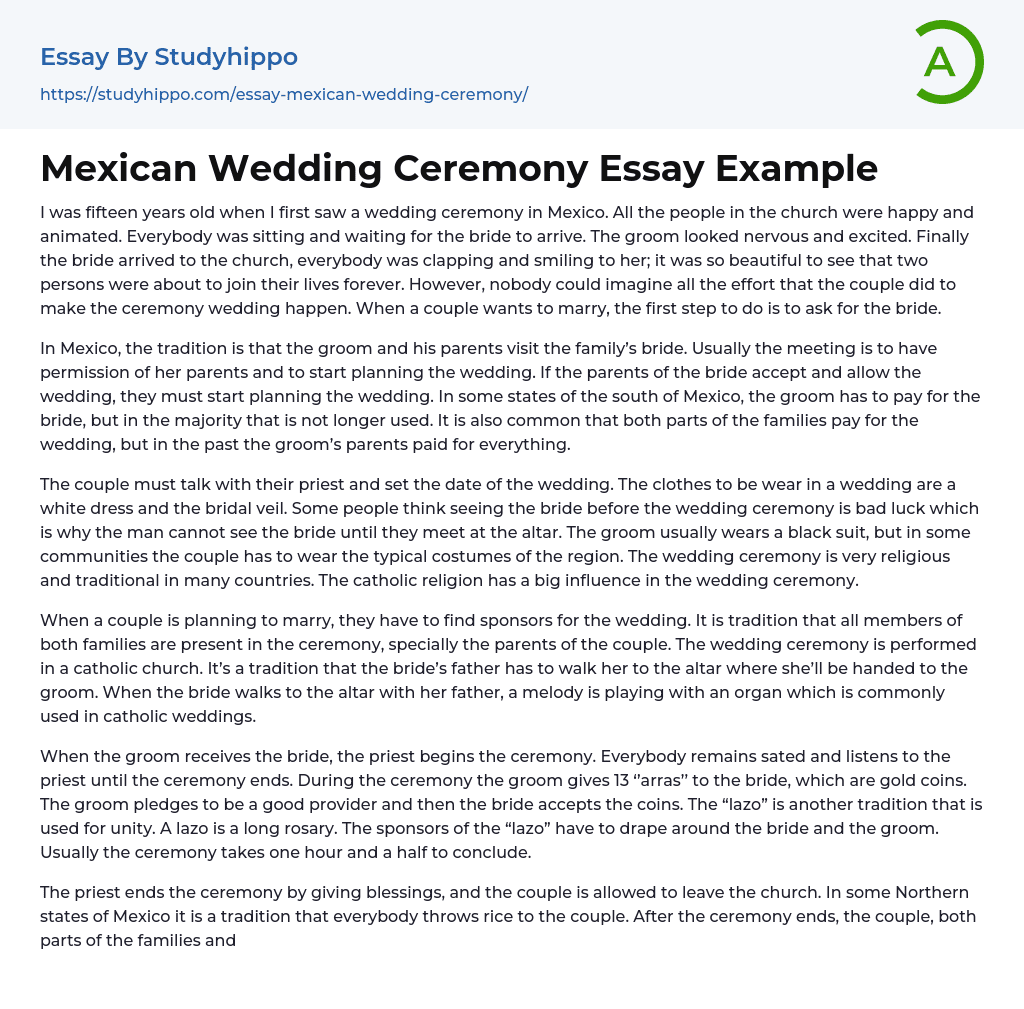In Mexico, the tradition is that the groom and his parents visit the family’s bride. Usually the meeting is to have permission of her parents and to start
...planning the wedding. If the parents of the bride accept and allow the wedding, they must start planning the wedding. In some states of the south of Mexico, the groom has to pay for the bride, but in the majority that is not longer used. It is also common that both parts of the families pay for the wedding, but in the past the groom’s parents paid for everything.
The couple must talk with their priest and set the date of the wedding. The clothes to be wear in a wedding are a white dress and the bridal veil. Some people think seeing the bride before the wedding ceremony is bad luck which is why the man cannot see the bride until they meet at the altar. The groom usually wears a black suit, but in some communities the couple has to wear the
typical costumes of the region. The wedding ceremony is very religious and traditional in many countries. The catholic religion has a big influence in the wedding ceremony.
When a couple is planning to marry, they have to find sponsors for the wedding. It is tradition that all members of both families are present in the ceremony, specially the parents of the couple. The wedding ceremony is performed in a catholic church. It’s a tradition that the bride’s father has to walk her to the altar where she’ll be handed to the groom. When the bride walks to the altar with her father, a melody is playing with an organ which is commonly used in catholic weddings.
When the groom receives the bride, the priest begins the ceremony. Everybody remains sated and listens to the priest until the ceremony ends. During the ceremony the groom gives 13 ‘’arras’’ to the bride, which are gold coins. The groom pledges to be a good provider and then the bride accepts the coins. The “lazo” is another tradition that is used for unity. A lazo is a long rosary. The sponsors of the “lazo” have to drape around the bride and the groom. Usually the ceremony takes one hour and a half to conclude.
The priest ends the ceremony by giving blessings, and the couple is allowed to leave the church. In some Northern states of Mexico it is a tradition that everybody throws rice to the couple. After the ceremony ends, the couple, both parts of the families and the entire guests is invited to the reception, which is where the ceremony will conclude, sometimes with a party or small festivity.
Some people rent a party salon, but it’s also common that the couple uses the bride’s house to celebrate the wedding.
In Mexico, the traditional food in a wedding is “el mole Negro”, a mix of chilies accompanied with meat, but the food can be different in some states or communities. It’s a traditional that the couple starts dancing with a romantic song, then all guests can start dancing, but they must pay the couple for dancing. In a Mexican wedding is also common to see dances such as ‘la vibora de la mar”, and also all the men in the party lift the groom and throw him in the air. The common music in a wedding is mariachi, banda, cumbias and sonidero.
When the party ends the bride throws the bouquet of flowers to all her single friends, the tradition says that whoever catches the bouquet will be the next to marry. The couple leaves the party together heading to their honey moon. Every culture has their own traditions; Mexico is a country with a lot of them, with influence from catholic religion. A Mexican wedding is a hard and long process from the planning to the reception, but the most important thing is to enjoy the ceremony.
- Adoption essays
- Aunt essays
- Babies essays
- Bedroom essays
- Caring essays
- Children essays
- Daughter essays
- Divorce essays
- Dog essays
- Dysfunctional Family essays
- Family Tradition essays
- Family Values essays
- Father essays
- Foster Care essays
- Friends essays
- Grandparent essays
- Home essays
- Hometown essays
- Husband essays
- Jealousy essays
- Love essays
- Marriage essays
- Mother essays
- Online Dating essays
- Parenting essays
- Parenting Teens essays
- Parents essays
- Relationship essays
- Room essays
- Sibling essays
- Sister essays
- Wedding essays
- Wife essays
- African American essays
- African American Culture essays
- American Values essays
- Asian American essays
- Chinese essays
- Ethnicity essays
- Ethnocentrism essays
- German essays
- Han Chinese essays
- Hispanic essays
- Identity essays
- Korean essays
- Mexican essays
- Nation essays
- Native American essays
- Race and Ethnicity essays
- White People essays




